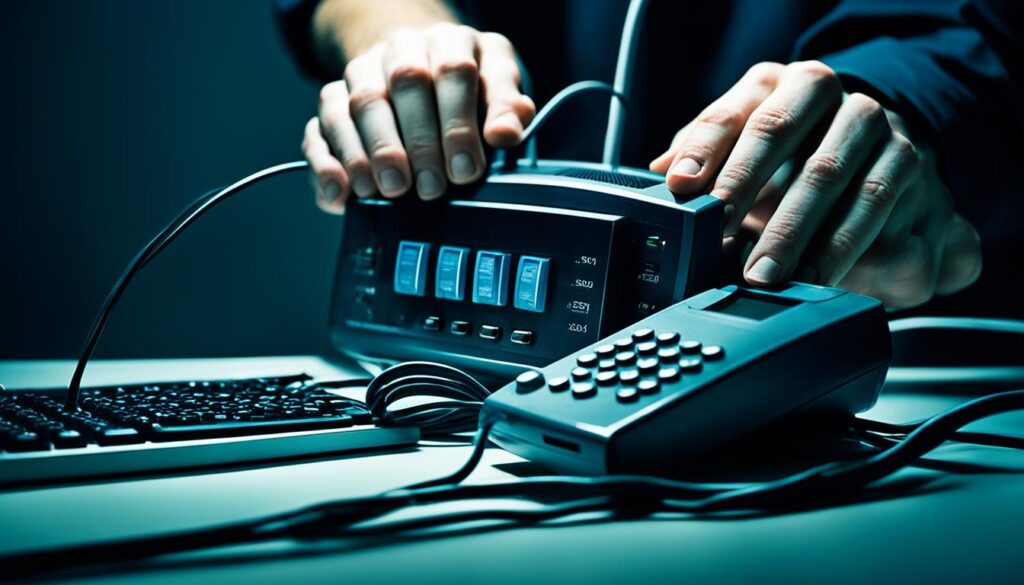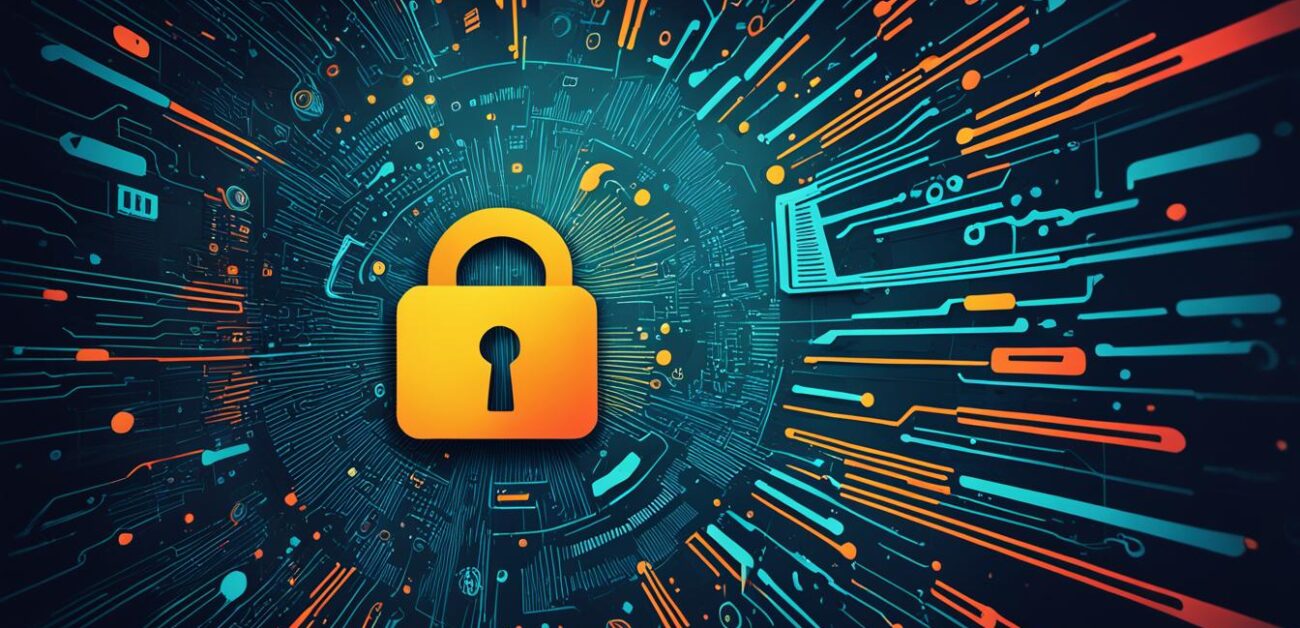Have you ever wondered what exactly hacking, cracking, and phreaking mean? Are they all the same, or do they have distinct meanings? And what implications do these activities have for cybersecurity? Let’s dive into the world of hacking, cracking, and phreaking to unravel their true definitions and understand their impact on our digital world.
Key Takeaways:
- Hacking, cracking, and phreaking are distinct activities with different meanings.
- Hackers seek knowledge and explore systems to improve cybersecurity.
- Crackers engage in malicious acts, causing damage and stealing information.
- Phreakers illegally access telephone systems for free calls and data manipulation.
- Understanding these activities is crucial for strengthening cybersecurity measures.
What is a Hacker?
A hacker is an individual who possesses a deep curiosity about the inner workings of computer software. Often, hackers are skilled programmers with advanced knowledge of operating systems and programming languages. They seek out security vulnerabilities or weaknesses, known as security holes, which they can exploit to gain unauthorized access, cause damage, or steal information. Hackers play a crucial role in cybersecurity by identifying weaknesses in systems and helping to improve their defenses.
| Characteristics of a Hacker | |
|---|---|
| Deep Curiosity | A hacker is driven by a passionate desire to understand how computer software operates. They have an insatiable curiosity that motivates them to explore the intricacies of technology and uncover its hidden secrets. |
| Advanced Programming Skills | Hackers are typically skilled programmers who possess in-depth knowledge of programming languages and operating systems. These technical skills enable them to analyze and manipulate computer software effectively. |
| Security Vulnerability Experts | Hackers specialize in identifying security vulnerabilities or weaknesses in computer systems. They thoroughly analyze the software, looking for any potential loopholes or gaps that can be exploited for unauthorized access. |
| Ethical Hackers | Some hackers choose to use their skills ethically by working with organizations to improve their cybersecurity defenses. Known as ethical hackers, they help identify and fix security vulnerabilities before they can be exploited by malicious actors. |
“Hackers are the architects of the digital world, pushing the boundaries of what’s possible and shedding light on the weaknesses that need to be addressed for a more secure cyberspace.”
Hackers are constantly pushing the boundaries of technology, fueled by their desire to understand and improve computer systems. While their motives may vary from curiosity to the pursuit of knowledge or even a desire for personal gain, hackers play a significant role in the evolving landscape of cybersecurity.

- Hackers possess advanced knowledge of computer software and operating systems.
- They actively seek out security vulnerabilities to exploit them for various purposes.
- Some hackers use their skills ethically to enhance cybersecurity defenses.
As technology evolves, the role of hackers in cybersecurity becomes increasingly critical. Their ability to identify security flaws and recommend improvements helps protect individuals, organizations, and systems from potential cyber threats.
Understanding Crackers
When it comes to unauthorized access and malicious activities, we enter the realm of crackers. Unlike hackers, crackers engage in activities that involve breaking into systems with malicious intent. Their actions include unauthorized access, destruction of data, and disruption of server services. Crackers can be easily identified due to the malicious nature of their actions.
Crackers often use their skills to bypass passwords, steal sensitive information, and even transfer money from bank accounts. Their activities pose significant risks to individuals and organizations, highlighting the importance of cybersecurity measures.
It is crucial for individuals and businesses to be aware of the potential threats posed by crackers and take appropriate steps to protect their systems and data. Implementing strong security measures, such as firewalls, encryption, and two-factor authentication, can help mitigate the risk of unauthorized access. Regularly updating software and educating users about safe online practices are also essential in maintaining cybersecurity.
The Role of Crackers in Cybersecurity
Crackers play a paradoxical role in the field of cybersecurity. While their actions expose vulnerabilities and weaknesses in systems, they also pose a considerable threat to individuals and organizations. Understanding their techniques and motivations can help cybersecurity professionals stay one step ahead.
“The malicious activities carried out by crackers highlight the critical need for robust cybersecurity measures. By understanding their methods, we can better protect our systems, sensitive data, and ensure the overall security of our digital landscape.”
The Essence of Phreaking
Phreaking is the practice of illegally gaining access to telephone systems, making it an early form of hacking. Phreakers were pioneers in breaking into telephone networks to bypass charges for long-distance calls. By using whistles or instruments to mimic the tones used by phone system operators, phreakers were able to route calls without paying hefty charges.
Today, phreakers have evolved their techniques and now also target company systems to manipulate data, posing a significant threat to communication networks and data security. Their activities involve illegal access to telephone systems, commonly referred to as phone hacking, and the manipulation of data within both phone and computer networks.
“Phreaking is a testament to the ingenuity and resourcefulness of individuals seeking to exploit vulnerabilities in telephone systems. It highlights the interconnectedness of communication networks and the potential risks they face from unauthorized access and data manipulation.” – Anonymous
Phreaking continues to be a relevant aspect of cybersecurity due to its historical connection to computer hacking and its potential impact on data integrity and network security.

Phreaking Techniques and Tools
To carry out their activities, phreakers employ various techniques and tools. The early days of phreaking saw the use of blue boxes, devices that could generate the necessary tones to manipulate the phone system. These tones were often used to access different functions within the system or bypass security measures.
As technology evolved, phone systems began using DTMF (dual-tone multi-frequency) signaling, which prompted phreakers to adapt their techniques. Tone dialers became popular tools, enabling phreakers to generate the specific DTMF tones required to gain unauthorized access to the system.
The following table provides an overview of commonly used phreaking techniques and tools:
| Technique/Tool | Description |
|---|---|
| Blue Boxes | Electronic devices used to generate specific tones for manipulating the phone system. |
| Tone Dialers | Devices capable of generating DTMF tones to gain unauthorized access to phone systems. |
These techniques and tools enable phreakers to exploit vulnerabilities in telephone systems, making it imperative for organizations to implement robust cybersecurity measures to protect against unauthorized access and data manipulation.
The Difference Between Hackers and Crackers
While hackers and crackers both engage in computer-related activities, there are significant differences between them. Hackers are individuals who hack with good intentions, seeking knowledge and aiming to protect systems by identifying vulnerabilities. They possess advanced computer knowledge and often work in organizations to enhance cybersecurity.
On the other hand, crackers engage in unauthorized access with malicious intent, causing harm and exploiting vulnerabilities for personal gain. They operate with no regard for ethical boundaries and engage in illegal activities to compromise systems and steal valuable information.
Hackers are considered ethical professionals, utilizing their skills for the betterment of cybersecurity. They adhere to strict ethical frameworks and often participate in what is known as ethical hacking, where they gather information about security holes and help organizations strengthen their defenses.
Crackers, on the other hand, are seen as unethical and engaging in illegal activities. Their actions can have severe consequences for individuals, businesses, and society as a whole.
Understanding the differences between hackers and crackers is essential in developing effective hacking prevention measures. By recognizing the motivations behind these individuals’ activities, organizations can better protect their systems and data from malicious intent.

The Evolution of Phreaking
Phreaking originated as the manipulation of telephone call routing. It involved groups of individuals who reverse-engineered the tones used in telephone systems to make long-distance calls for free. Phreakers used electronic tone generators known as blue boxes to replicate these tones and exploit the system. With the advent of computerized phone systems, phreaking evolved and became closely linked with computer hacking. The involvement of phreakers in computer hacking highlighted the interconnectedness of these activities and the importance of cybersecurity.
Origins of Phreaking
In the early days of telecommunications, phreaking emerged as a subculture of individuals who were fascinated by the inner workings of the telephone network. They discovered that certain whistles could replicate the frequency used in phone signaling, allowing them to manipulate the system. Phreaks experimented with dialing around the telephone network, listening to tones, and reading technical journals to understand how the system worked.
“We started out as phone phreaks, experimenting with the weird and wonderful world of late ’60s telephony.” – Captain Crunch
The Blue Box Era
Phreakers developed devices called blue boxes, named after the blue-colored phone line enclosures, to explore the telephone network further. Blue boxes were electronic tone generators that could produce the necessary tones to manipulate the system. Phreakers used these devices to make free long-distance calls by mimicking the tones used by phone system operators to route calls.
Blue boxes became popular among phreakers, enabling them to exploit the telephone network and make calls without being charged. Phreaking communities grew, sharing knowledge and techniques for evading the system’s controls.
| Technology | Year | Impact |
|---|---|---|
| Blue Boxes | 1960s-1970s | Enabled phreakers to make free long-distance calls |
| Black Boxes | 1970s | Allowed phreakers to bypass payphone charges |
| Red Boxes | 1970s | Generated tones that tricked payphones into refunding coins |
Phreaking and Computer Hacking
As computerized phone systems began to replace analog systems, phreaking and computer hacking became closely intertwined. Phreakers adapted their techniques to exploit the vulnerabilities found in computer networks, revealing the interconnectedness of these activities. The knowledge gained from phreaking provided a foundation for phreakers’ involvement in computer hacking, highlighting the importance of cybersecurity in protecting digital infrastructure.

In today’s interconnected world, the evolution of phreaking continues, with phreakers and hackers constantly adapting their techniques to exploit new technologies and vulnerabilities. The rise of cybersecurity as a crucial field reflects the ongoing battle to protect digital systems from unauthorized access and manipulation.
A Brief History of Phreaking
In the 1960s, a group of individuals stumbled upon a fascinating discovery – certain whistles could replicate the frequency used in phone signaling. Intrigued by this revelation, these early phreaks began experimenting with dialing around the telephone network, listening to tones, and diving into technical journals in an effort to understand how the system worked.
Driven by curiosity and a desire to explore the limits of the telephone network, phreaks used a variety of devices such as blue boxes, black boxes, and red boxes to push the boundaries of what was possible. These innovative tools allowed them to explore the network, navigate early conference call circuits, and even make free phone calls.
Phreaking quickly gained popularity in universities and underground communities, captivating the minds of those seeking to understand and manipulate the intricate workings of the telephone system. Little did they know that their experiments would lay the foundation for the future of computer hacking.

“Phreaking was more than just a hobby – it was a movement that challenged the limitations imposed by the telephone system. It opened doors to new possibilities and foreshadowed the need for robust cybersecurity measures.”
Phreaking Techniques and Tools
Phreaking techniques and tools have evolved over the years, allowing phreakers to manipulate telephone systems and gain unauthorized access. One of the earliest tools used in phreaking was the blue box, which generated tones to exploit vulnerabilities in the phone system. Phreakers would experiment with different frequencies, such as the 2600 Hz tone, to manipulate the system and make free phone calls.
As phone systems transitioned to DTMF (dual-tone multi-frequency) signaling, phreakers adapted by using tone dialers to generate the required tones. These tone dialers allowed phreakers to control the system and gain unauthorized access to restricted services.
The evolution of phreaking tools and techniques highlights the constant battle between individuals seeking to exploit vulnerabilities and those striving to protect systems. Phreaking activities underscore the importance of robust cybersecurity measures to prevent unauthorized access and maintain the integrity of communication networks.
Frequency Manipulation and DTMF Tones
Phreakers use frequency manipulation as a key technique in their activities. By experimenting with different tones and frequencies, phreakers can bypass security measures and gain unauthorized access to telephone systems. The 2600 Hz tone, for example, was a significant frequency used in early phreaking to control the phone network and make free calls.
However, with the transition to DTMF signaling, phreakers had to adjust their techniques. DTMF tones consist of two simultaneous tones to represent different characters or commands. Phreakers started using tone dialers to generate the required DTMF tones, allowing them to gain control over the system and manipulate phone services.
The Blue Box: A Phreaker’s Tool
The blue box is an iconic tool associated with early phreaking. It was an electronic device capable of generating the precise tones used in telephone systems. By connecting the blue box to a payphone or landline, phreakers could mimic the tones used by phone system operators and gain access to restricted services, make free calls, or manipulate the network. The invention and use of blue boxes marked a significant milestone in the evolution of phreaking techniques.
Phreaking and Computer Hacking
Phreaking and computer hacking are closely intertwined, with phreakers being among the pioneers in exploring vulnerabilities within telephone systems. Their activities played a pivotal role in paving the way for the emergence of computer hacking. This interconnection emphasizes the critical importance of implementing robust cybersecurity measures. Phreaking and computer hacking share commonalities as both involve unauthorized access to systems, manipulation of data, and the potential for significant harm.
Phreakers, originally targeting telephone systems, expanded their endeavors to include computer hacking as technology advanced. As a result, they contributed to the evolution of hacking techniques and tools. This symbiotic relationship underscores the need for comprehensive cybersecurity strategies that address the threats posed by both activities.
Understanding the close relationship between phreaking and computer hacking is fundamental in developing effective cybersecurity measures. Organizations must recognize that the unauthorized access and manipulation of data are not limited to one domain but extend across interconnected systems. By acknowledging this interconnectedness, cybersecurity professionals can develop strategies that address the shared vulnerabilities and potential risks.
Quote: “Phreaking served as a stepping stone towards computer hacking, demonstrating the vulnerabilities inherent in interconnected systems.” – Cybersecurity Expert
The Implications for Cybersecurity
The association between phreaking and computer hacking significantly impacts cybersecurity. By recognizing the interdependence of these activities, organizations can better understand the potential risks they face. Both phreaking and computer hacking involve breaching systems, manipulating data, and compromising security. This underscores the need for robust cybersecurity measures that encompass not only traditional computer networks but also interconnected systems such as telecommunications networks.
Combating the threats posed by phreaking and computer hacking necessitates a multifaceted approach. Organizations must continuously assess and enhance their security measures to safeguard against unauthorized access and data manipulation. Additionally, it is crucial to foster a culture of cybersecurity awareness among employees, ensuring that they understand the risks associated with these activities and the role they play in maintaining a secure environment.
Phreaking vs. Computer Hacking
| Phreaking | Computer Hacking |
|---|---|
| Originated in telecommunication systems | Originated in computer systems |
| Manipulation of telephone networks | Manipulation of computer networks |
| Focus on free phone calls and data manipulation | Focus on unauthorized access, data theft, and system disruption |
| Used whistles and blue boxes to exploit vulnerabilities | Utilizes coding and software vulnerabilities to exploit systems |
| Evolved to encompass computer hacking | Continues to evolve, incorporating advanced hacking techniques |
The table above highlights the contrasting factors between phreaking and computer hacking. While phreaking originated in telecommunication systems and focused on free phone calls, computer hacking emerged within computer networks with the aim of unauthorized access and data theft. Recognizing these distinctions is vital in formulating effective cybersecurity strategies that address the unique risks posed by each activity.
Conclusion
Hacking, cracking, and phreaking are distinct activities that have significant implications for cybersecurity. While hackers have good intentions and aim to protect systems, crackers engage in malicious activities that compromise data and security. Phreakers, the original telephone system hackers, also contribute to cybersecurity risks. Understanding the differences between hackers, crackers, and phreakers is essential in developing effective prevention and defense mechanisms against cyber threats. Cybersecurity measures must address the evolving techniques and tools used in hacking, cracking, and phreaking to protect individuals and organizations.
As technology continues to advance, the landscape of cybersecurity becomes more complex. It is crucial for individuals and organizations to stay vigilant and implement robust security measures to safeguard against hacking, cracking, and phreaking attempts. Regular security assessments, vulnerability testing, and the implementation of reliable security systems and protocols are key to maintaining the integrity of computer networks and data.
The implications of hacking, cracking, and phreaking extend beyond individual victims. Large-scale cyber attacks can disrupt essential services, compromise national security, and result in financial losses. To mitigate the risks posed by these activities, governments, businesses, and individuals must collaborate to develop comprehensive cybersecurity strategies, share threat intelligence, and invest in ongoing cybersecurity awareness and training programs.
By staying informed about the latest trends and techniques in cybersecurity, individuals can better protect themselves from potential threats. It is essential to remain cautious and adopt best practices such as using strong and unique passwords, keeping software and devices updated, and being wary of suspicious emails and links. Together, we can create a safer digital environment and safeguard our valuable information from the ever-evolving threats of hacking, cracking, and phreaking.
